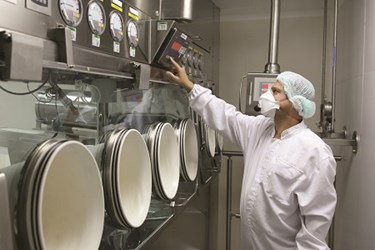Choosing The Right Partner For High Potency API Manufacturing
By Brian James, Ph.D., Rondaxe

The pharmaceutical landscape continues to evolve, with R&D focusing on targeted drugs to treat an ever-expanding variety of conditions. At the forefront of this growth are high-potency active pharmaceutical ingredients (HPAPIs), which are featured prominently in oncology research and treatment. Approximately 25 percent of drugs currently in development worldwide are classified as highly potent, and this market is expected to reach nearly $22 billion by 2022.1
The rising number of biotech and pharmaceutical companies, coupled with increasing investments in the R&D sector in developing economies such as Asia and Latin America, are key factors expected to fuel the explosive growth over the forecast period.
Highly potent compounds can have significant benefits, but they also present multiple challenges to companies in manufacturing, especially during commercial operations. To capitalize on this fast-growing market, a company must be prepared to safely handle HPAPIs with the appropriate expertise; manufacturing the quantities necessary for commercial projects can be a daunting task. Given the risks HPAPIs present in cross contamination and containment, it is critical to carefully consider manufacturing and handling approaches. Outsourcing your HPAPI to a well-qualified CDMO is often the wisest choice from a strategic and economic outlook.
The discussion below outlines some of the considerations for HPAPI manufacturing and CDMO selection. For companies that decide to outsource HPAPI manufacturing, it is critically important to understand what goes into the process of manufacturing highly potent compounds. Here are some questions to consider before selecting a CDMO:
Does the company have experience with HPAPIs?
In the case of HPAPI manufacturing, past results are often indicative of future performance. Handling HPAPIs requires smooth integration through multiple areas, including equipment, personnel, and timing.
Contamination-control protocols are central in manufacturing HPAPIs. The two basic approaches include engineering and administrative-based controls. Engineering protocols focus on technology, equipment, and facility design, while the administrative-based approach targets processes and procedures. For maximum safety and efficiency, engineering controlled processes are far superior and often include segregated facilities for handling HPAPIs to mitigate potential cross contamination.
When evaluating a facility for HPAPI manufacturing, the following questions must be addressed:
- Has the facility been specifically designed for HPAPI manufacturing?
- Is the facility overly reliant on personal protection equipment (PPE) for safety and containment?
- Does the facility have the appropriate industrial hygiene data to ensure adequate performance of engineering controls?
- Is the facility equipped for both small and commercial scale?
- Can the facility move your project through the entire cycle?
- Does the facility have regulatory compliance management, quality system programs, and an active training program for personnel?
Also, don’t forget the one factor that is easy to overlook: control and containment of waste. A CDMO with experience in HPAPIs will either have invested in abatement systems such as in-line gas scrubbers and HEPA filters or will have an alternative plan in place.
How committed is the manufacturer?
Price and capacity are important factors in choosing the right CDMO for a HPAPI project, but prioritizing these factors at the expense of other areas is a risky strategy. On the other hand, a CDMO with extensive engineering controls and technical capabilities is only one piece of the picture. Experience in the successful management of HPAPI projects with sustained evidence of a long-term commitment is equally important. Factors such as organizational commitment can seem difficult to assess, but they can derail a project if they are not present. What would be some signs that a potential partner is not fully committed to HPAPI production? A CDMO outsourcing critical analytical development, for example, is a red flag that the company may not be fully committed to HPAPI production.
In addition, reliance on outsourcing should prompt questions about the agility and response time of the CDMO in case of a problem. CDMOs that lack in-house expertise in key areas such as analytical or toxicology will not be as flexible and responsive. The questions of responsiveness and reliability become key here: How can a CDMO that outsources a portion of project development guarantee reliability? A thorough environment, health, and safety (EHS) audit coupled with careful questioning and a site visit can go a long way in assuaging concerns about a potential CDMO’s track record and capabilities. An audit can take time, but there is no substitute for objective and direct observation.
Although it is important to know the right questions to ask, it is also useful to know what practices to avoid. Here are some warning signs that the CDMO you have selected is not only a poor fit, but a recipe for disaster:
- Little to no experience in manufacturing HPAPIs; an inability to evaluate the potency of a compound
- Retrofitting existing laboratories to accommodate high-potency compounds that is slipshod and poorly done
- An emphasis on administrative processes and PPE as opposed to engineering controls to prevent cross contamination
Although the most expensive CDMOs are not always the best, the manufacture of HPAPIs is one area where you often get what you pay for. Handling HPAPIs requires an investment in expensive containment infrastructure, which can be complex to engineer, install, and maintain. An emphasis on low-cost service offerings should be a red flag — you may be required to accept substantial risks in safety, contamination, and supply chain integrity.
The challenges of HPAPI manufacturing make outsourcing an attractive, cost-effective option for many biotech and pharmaceutical companies. Considering the risks, sourcing teams should exercise caution in choosing a CDMO, taking time to partner with a company with a proven track record of success. Entering the HPAPI sector is about more than just installing the technical capabilities; it is a commitment to safety and quality that shapes the entire approach of the company. Partners that take a comprehensive and serious approach are best placed to meet project demands without compromising the health of their employees and the environment.
References:
About The Author:
 Brian James, Ph.D., MBA, is the SVP of operations at Rondaxe, a pharmaceutical CMC consulting and software firm. Brian oversees project management, API synthesis design, and API/formulation sourcing support to Rondaxe clients. He manages and oversees projects ranging from pre-IND chemistry development to pre-launch validation and material sourcing for late-stage clinical trials. Prior to joining Rondaxe, he was with Bristol-Myers Squibb, where he honed his skills and expertise in API synthesis and sourcing strategies. Brian received his Ph.D. in chemistry from University of California and his MBA from Le Moyne College, and performed his post-doctoral fellowship at Colorado State University.
Brian James, Ph.D., MBA, is the SVP of operations at Rondaxe, a pharmaceutical CMC consulting and software firm. Brian oversees project management, API synthesis design, and API/formulation sourcing support to Rondaxe clients. He manages and oversees projects ranging from pre-IND chemistry development to pre-launch validation and material sourcing for late-stage clinical trials. Prior to joining Rondaxe, he was with Bristol-Myers Squibb, where he honed his skills and expertise in API synthesis and sourcing strategies. Brian received his Ph.D. in chemistry from University of California and his MBA from Le Moyne College, and performed his post-doctoral fellowship at Colorado State University.
